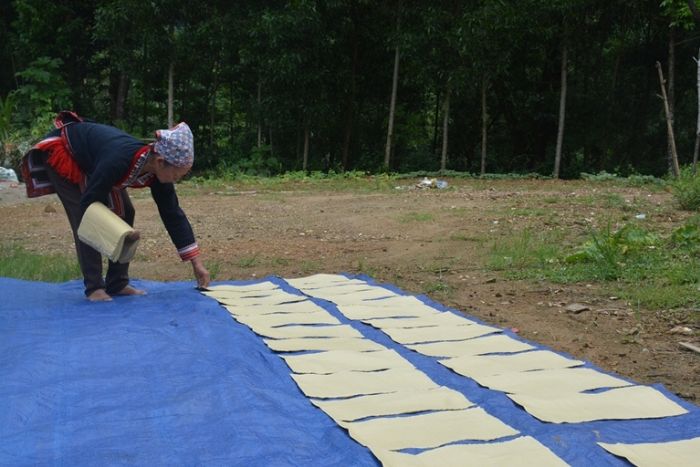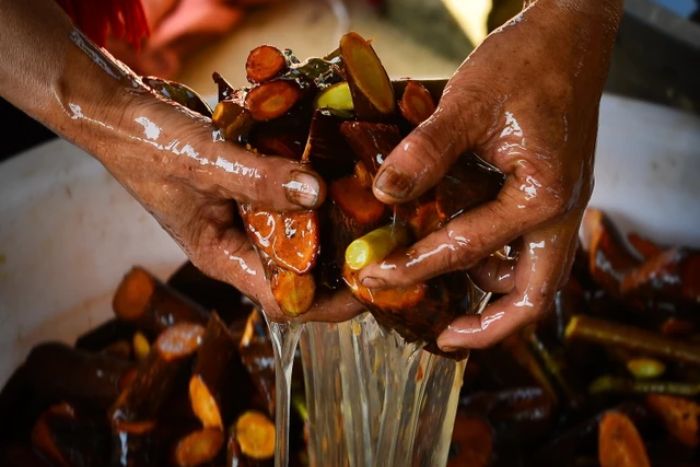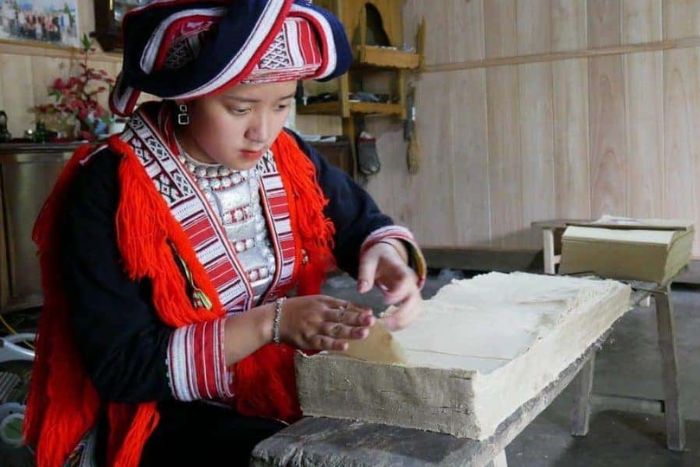Thanh Son Village: Paper-making Craft Village In Ha Giang Vietnam

Located amidst the karst mountains of Ha Giang, Thanh Son village in Bac Quang district is renowned as a Thanh Son paper-making craft village, attracting numerous national and international visitors. By visiting this ethnic village, you'll not only have the chance to immerse yourself in the culture of the local ethnic minorities but also explore the paper production methods practiced by the village artisans. Discover in this article what makes the paper-making process at Thanh Son village so unique!
Table of Contents
I. Overview of Thanh Son village in Ha Giang
- Location: Bac Quang district, Ha Giang province, northern Vietnam.
Thanh Son village (Vietnamese name: thôn Thanh Sơn) is located about 3 km southwest of Viet Quang town, along National Route 279, in Bac Quang District. This hidden gem on the Ha Giang Loop map is less known compared to the districts of Quan Ba, Yen Minh, Hoang Su Phi and Meo Vac,...

Thanh Son village is home to nearly 200 households, the majority of whom are from the Red Dao ethnic group. Traditionally, the main economic activities in Thanh Son village were agriculture and livestock. The residents cultivated rice, corn, cassava, and fruit trees, and raised animals such as buffaloes, chickens, and cows. As a result, the daily life of the Dao people in Thanh Son village was very simple, rustic, and peaceful.
In addition to agriculture, the residents of Thanh Son village also practice traditional paper-making craftsmanship, a method passed down for over 100 years. Initially, the Dao people made paper only for personal use and local trade within Thanh Son village and neighboring villages. Their production was modest and not intended for national sale.
However, gradually, the Dao's paper-making craft in Thanh Son village gained recognition and attracted many visitors eager to discover this traditional paper-making method. On September 4, 2018, the Minister of Culture, Sports, and Tourism recognized the Dao's paper-making technique as a national intangible cultural heritage in the category of popular knowledge.
Furthermore, with the support of local authorities, the Thanh Son Village Paper Production Cooperative was established in July 2022 to increase paper production for commercialization, helping to preserve the cultural identity of the Dao ethnic group and boost local incomes. The Dao people of Thanh Son village are also becoming more aware of the importance of passing on and preserving their ancestral paper-making craft while aiming for sustainable tourism development in the village.

II. Why visit Thanh Son village ?
If you are a cultural enthusiast during your travels, particularly interested in the customs and daily life of ethnic minorities in northern Vietnam, Thanh Son village will be an ideal destination for you.
First, you will meet the Red Dao people and learn about their lifestyle and traditions. The Red Dao ethnic group typically wears black clothing adorned with red patterns. Their distinctive feature is undoubtedly the bright red hat they proudly wear. The local residents are also very warm and welcome visitors to Thanh Son village with open arms!
Next, you will have the opportunity to closely observe how they make paper using traditional methods, which is the highlight of Thanh Son paper-making craft village. Thanh Son paper is made from "măng vầu", a flowering plant from the Poaceae family, grown exclusively in Thanh Son village.
The paper-making process is lengthy: the raw materials are harvested in March, and the paper is made in August. Thus, producing Thanh Son paper requires considerable time and skill, which adds great value to this product and makes it one of the national intangible cultural heritages.
In summary, Thanh Son village is a must-visit destination for travelers seeking authenticity, ethnic culture, and natural beauty. Your visit will not only contribute to the preservation of the local heritage of the Dao ethnic group but will also leave you with unforgettable memories.

III. Discover how Thanh Son paper is made
To create traditional paper, the Dao people of Thanh Son village must complete several meticulous steps without using any chemicals.
The first step involves selecting the raw materials, with "măng vầu" bamboo being the primary ingredient for making Thanh Son paper. In March, the locals harvest this bamboo, which is then fermented by soaking it in lime water. The lime water helps to bleach the raw material while softening the bamboo and releasing its sap.
Next, the Dao use a vine gathered from the forests near Thanh Son village to mix with the bamboo to enhance the adhesive properties of the paper pulp. Typically, the fermentation of the raw materials begins in May so that they are ready by August for the paper-making process.

This stage is also very complex, requiring physical strength and great precision. It includes: placing the raw material into the shaping basin, mixing the pulp, shaping the paper, pressing the material to form sheets, separating the layers of paper, and finally drying the sheets. The last step is to collect and store the paper sheets.
To preserve the know-how and perpetuate this tradition, the Dao ethnic group in Thanh Son village only passes on the manufacturing secrets to their descendants. Apprentices must follow specific rules while practicing this craft.
Defective paper products are soaked again in lime water for recycling, rather than being sold, to maintain the reputation of Thanh Son paper-making craft village. This further highlights the value of the traditional craftsmanship of the Dao people in Thanh Son village.

IV. Conseils de voyage au village de Thanh Son
- The best time to visit Thanh Son village in Ha Giang is from August to September. This is when the Dao people complete a new production of paper. Additionally, it is also the ripe rice season in rice terraces, offering breathtaking landscapes in Ha Giang.
- It is not advisable to travel to Thanh Son village in June and July, as this is the rainy season in Ha Giang.
- You should prepare some necessary items for your trip to Thanh Son village, including: cash in VND for purchases, sports shoes for exploring the village, a light jacket for the cool evenings, as well as a hat and sunscreen for daytime.
- It is recommended to have a local guide with you to facilitate communication with the locals and better understand the paper-making process at Thanh Son village.
- Access to Thanh Son village can be challenging due to winding mountain passes. Therefore, it is advisable to choose an organized tour with transportation and a private driver to fully enjoy your trip.
- Near Thanh Son village, you can visit other tourist attractions such as Meo Vac market, Ma Pi Leng pass, Nho Que river, Tu San canyon, and more.

Here is all the useful information about Thanh Son village, a paper-making craft village in Ha Giang. To facilitate your visit to this cultural village, please contact Autour Asia, your Vietnam local tour operators, to organize a tour by motorbike or car. Our travel consultants will help you create a personalized itinerary to ensure you have an unforgettable trip in Vietnam!
In addition to the travel period and transportation methods to Thanh Son village mentioned in the article, there are a few following points you have to remember when interacting with the locals in the village:
- Avoid speaking loudly; this can be considered quite rude, especially to Dao women.
- Do not point at others when talking.
- Specifically, you should not tease the ethnic girls in Ha Giang with any gestures!
Yes, there are many well-known traditional craft villages in Ha Giang. One notable example is the Lung Tam weaving village of the Hmong people, located in Quan Ba District. This village has a wide variety of colorful traditional costumes and also preserves unique textile weaving techniques for you to explore!
Related travel guide
Other similar articles
CUSTOMIZABLE BY LOCAL EXPERTS
Personalized trip at the original price!
REFUND GUARANTEE
We believe in our work and promise to give you money back.
GOOD PRICE / QUALITY
95% satisfied more than expected!
24/7 LOCAL SUPPORT
We are always available online to provide assistance at any time.
Most read articles
Autour Asia is highly recommended on
Embracing the mission of "Satisfied more than expected" and providing authentic experiences, we have received numerous recommendations on reputable travel forums:























